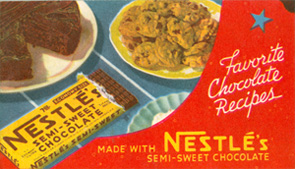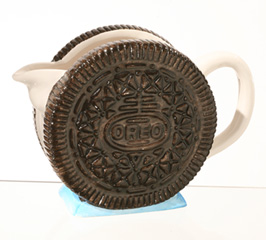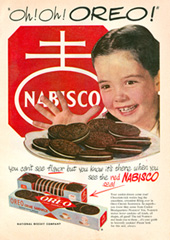| |
Chocolate Chip Cookies
Stories vary as to the exact origins of the chocolate chip cookie. However, they all agree that it was developed accidentally in 1930 by Ruth Wakefield, while baking some of her favorite cookies. Wakefield was a dietitian and food lecturer until she and her husband took over the Toll House Inn, in Whitman, Massachusetts. At the Toll House, she served home-cooked meals for tourists and local customers.
Whether she purposefully substituted or accidentally added cut-up bits from a Nestlé’s semi-sweet chocolate bar into her famous Butter Drop Do cookies, the rest is history. The huge popularity of Ruth Wakefield’s new, mouth-watering cookie eventually led Nestlé’s to mass produce chocolate morsels, and to include her recipe for Toll House cookies on the back of every package. Chocolate chip cookies would become America’s favorite home-baked cookie.
 |
 |
| Nestle’s recipe booklet, 1940. (Front and back cover) ID.2008.44.1 |
 |
| Nestle’s recipe booklet, 1940. (Inside pages) ID.2008.44.1 |
Bosco® Chocolate Syrup
If you’re a Baby Boomer, chances are that the word “Bosco®” almost immediately brings to mind the jingle from the old television commercial, beginning with the verse:
I love Bosco®,
It’s rich and chocolate-y;
Chocolate-flavored Bosco®
Is mighty good for me.
The advertisement pictured here was a direct appeal to the moms of these TV-watching kids. It not only promised a convenient shaker, but claimed that the new recipe was “super-fortified” for healthy, growing children.
Bosco®, introduced in 1928, was apparently no match for the products of the more dominant brands, like Hershey’s chocolate syrup (1926) and Nestlé’s Quik (1948). Yet, Bosco® not only still exists, but is happily living on in our popular culture, including the inclusion of its jingle in the soundtrack of the movie Shrek 2.
 |
| Bosco® advertisement, 1963-66. ID.2008.62.1 |
Oreos®
Youngsters from virtually every generation of the last century have been able to enjoy an Oreo® cookie dipped in a glass of whole milk, or have mischievously “unscrewed” the chocolate disks of an Oreo® to eat out its creamy center. Oreo® cookies were introduced by Nabisco in 1912, to compete with the British “biscuit”-type cookies that Nabisco claimed were too “ordinary.” The first Oreos® were available with either lemon meringue or white cream filling.
Over 500 billion Oreo® cookies have been sold since they were first introduced, making them the best-selling cookie of the 20th century.
 |
 |
| Oreo® milk pitcher, 1985-1995. ID.2008.52.1 |
Oreo® advertisement, 1951. ID.2008.70.1 |
S’mores
Chocolate seems to blend perfectly with crispy Graham crackers and soft, puffy marshmallows. Products combining these three ingredients have been around for almost a century, including Mallomars (Nabisco, 1913) and Moon Pies (Chattanooga Bakery, Tennessee, 1917). No one knows who invented S’mores, the camping treat made by sandwiching a toasted marshmallow and a piece of chocolate between two graham crackers. The recipe for these gooey, delicious treats first appeared in the 1927 Girl Scout Handbook as “Some Mores.” Today, portable restaurant and home kits are bringing the fun of making and eating S’mores indoors.
| |
-- Donna R. Braden, Curator of Public Life |
|

